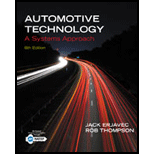
Automotive Technology: A Systems Approach (MindTap Course List)
6th Edition
ISBN: 9781133612315
Author: Jack Erjavec, Rob Thompson
Publisher: Cengage Learning
expand_more
expand_more
format_list_bulleted
Concept explainers
Textbook Question
Chapter 55, Problem 4ASRQ
Technician A says that a faulty accumulator will allow contaminants to enter the A/C system. Technician B says that a damaged compressor will allow contaminants to enter the A/C system. Who is correct?
- Technician A only
Expert Solution & Answer
Want to see the full answer?
Check out a sample textbook solution
Students have asked these similar questions
B
150 mm
120 mm
PROBLEM 15.193
The L-shaped arm BCD rotates about the z axis with a constant
angular velocity @₁ of 5 rad/s. Knowing that the 150-mm-
radius disk rotates about BC with a constant angular velocity
@2 of 4 rad/s, determine (a) the velocity of Point A, (b) the
acceleration of Point A.
Answers:
V₁ =-(0.600 m/s)i + (0.750 m/s)j - (0.600 m/s)k
a=-(6.15 m/s²)i- (3.00 m/s²)j
3
Answer:
002
PROBLEM 15.188
The rotor of an electric motor rotates at the constant rate
@₁ = 1800 rpm. Determine the angular acceleration of the rotor as the
motor is rotated about the y axis with a constant angular velocity 2
x of 6 rpm counterclockwise when viewed from the positive y axis.
α = (118.4 rad/s²)i
12 in..
10 in.
PROBLEM 15.187
At the instant considered the radar antenna shown rotates about
the origin of coordinates with an angular velocity
@ = ai + @j+wk Knowing that (VA) = 15 in./s,
(VB), 9 in./s, and (VB), = 18 in./s, determine (a) the angular
velocity of the antenna, (b) the velocity of point A.
B
10 in.
Answers:
=
(0.600 rad/s)i - (2.00 rad/s) j + (0.750 rad/s)k
V₁ = (20.0 in./s)i + (15.00 in./s) j + (24.0 in./s)k
Chapter 55 Solutions
Automotive Technology: A Systems Approach (MindTap Course List)
Ch. 55 - What should you do if you suspect that an...Ch. 55 - Explain how dye can be used to find leaks in the...Ch. 55 - What is the purpose of the thermostatic switch in...Ch. 55 - Why should the probe of an electronic leak...Ch. 55 - How will air trapped in the A7C system affect...Ch. 55 - Which of the following statements best defines the...Ch. 55 - Which of the following statements is not true...Ch. 55 - To charge an air-conditioning system while it is...Ch. 55 - All of the following are true statements about...Ch. 55 - A very important part of a performance test on an...
Ch. 55 - While conducting a pressure test on an A/C system,...Ch. 55 - The high-side pressure on a system with a cycling...Ch. 55 - When checking an A/C system, the evaporators inlet...Ch. 55 - All of these are good reasons for replacing an...Ch. 55 - In an AZC system, if the low-side pressure is...Ch. 55 - Technician A says that evacuating (pumping down)...Ch. 55 - Technician A says that some refrigerant leaks can...Ch. 55 - Technician A says that the presence of oil around...Ch. 55 - Technician A says that a faulty accumulator will...Ch. 55 - Technician A says that air in the system can cause...Ch. 55 - Technician A feels up and down the face or along...Ch. 55 - Technician A says that a manifold gauge set can be...Ch. 55 - While discussing an inoperative blend air door:...Ch. 55 - Two technicians were discussing how comparing the...Ch. 55 - While conducting an A/C system performance test:...
Knowledge Booster
Learn more about
Need a deep-dive on the concept behind this application? Look no further. Learn more about this topic, mechanical-engineering and related others by exploring similar questions and additional content below.Similar questions
- 3. An engine has three cylinders spaced at 120° to each other. The crank torque diagram can be simplified to a triangle having the following values: Angle 0° Torque (Nm) 0 (a) What is the mean torque? 60° 4500 180° 180° to 360° 0 0 (b) What moment of inertia of flywheel is required to keep the speed to within 180 ± 3 rpm? (c) If one cylinder of the engine is made inoperative and it is assumed that the torque for this cylinder is zero for all crank angles, determine the fluctuation in speed at 180rpm for the same flywheel. (a) 3375 Nm (b) 50kgm (c) ±21 rpmarrow_forwardProb 5. Determine the largest load P that can be applied to the frame without causing either the average normal stress or the average shear stress at section a-a to exceed o-150 MPa and 1-60 MPa, respectively. Member CB has a square cross section of 25 mm on each side. 2 m FAC 1.5 m Facarrow_forwardDerive the component transformation equations for tensors shown below where [C] = [BA] is the DCM (direction cosine matrix) from frame A to B. ^B [T] = [C]^A [T] [C]^Tarrow_forward
- Calculate for the vertical cross section moment of inertia for both Orientations 1 and 2 of a 1 x 1.5 in. horizontal hollow rectangular beam with wall thickness of t = 0.0625 in. Use the equation: I = ((bh^3)/12) - (((b-2t)(h-2t)^3)/12)arrow_forwardPlease answer 'yes' or 'no' and 'is' or 'is not' for the following:arrow_forwardConsider a large 23-cm-thick stainless steel plate (k = 15.1 W/m-K) in which heat is generated uniformly at a rate of 5 x 105 W/m³. Both sides of the plate are exposed to an environment at 30°C with a heat transfer coefficient of 60 W/m²K. The highest temperature will occur at surfaces of plate while the lowest temperature will occur at the midplane. Yes or No Yes Noarrow_forward
- My answers are incorrectarrow_forwardPicturearrow_forwardWhat is the weight of a 5-kg substance in N, kN, kg·m/s², kgf, Ibm-ft/s², and lbf? The weight of a 5-kg substance in N is 49.05 N. The weight of a 5-kg substance in kN is KN. The weight of a 5-kg substance in kg·m/s² is 49.05 kg-m/s². The weight of a 5-kg substance in kgf is 5.0 kgf. The weight of a 5-kg substance in Ibm-ft/s² is 11.02 lbm-ft/s². The weight of a 5-kg substance in lbf is 11.023 lbf.arrow_forward
- Mych CD 36280 kg. 0.36 givens Tesla truck frailer 2017 Model Vven 96154kph ronge 804,5km Cr Powertrain Across PHVAC rwheel 0.006 0.88 9M² 2 2kW 0.55M ng Zg Prated Trated Pair 20 0.95 1080 kW 1760 Nm 1,2 determine the battery energy required to meet the range when fully loaded determine the approximate time for the fully-loaded truck-trailor to accelerate from 0 to 60 mph while Ignoring vehicle load forcesarrow_forward12-217. The block B is sus- pended from a cable that is at- tached to the block at E, wraps around three pulleys, and is tied to the back of a truck. If the truck starts from rest when ID is zero, and moves forward with a constant acceleration of ap = 0.5 m/s², determine the speed of the block at D the instant x = 2 m. Neglect the size of the pulleys in the calcu- lation. When xƊ = 0, yc = 5 m, so that points C and D are at the Prob. 12-217 5 m yc =2M Xparrow_forwardsolve both and show matlab code auto controlsarrow_forward
arrow_back_ios
SEE MORE QUESTIONS
arrow_forward_ios
Recommended textbooks for you
 Automotive Technology: A Systems Approach (MindTa...Mechanical EngineeringISBN:9781133612315Author:Jack Erjavec, Rob ThompsonPublisher:Cengage Learning
Automotive Technology: A Systems Approach (MindTa...Mechanical EngineeringISBN:9781133612315Author:Jack Erjavec, Rob ThompsonPublisher:Cengage Learning Refrigeration and Air Conditioning Technology (Mi...Mechanical EngineeringISBN:9781305578296Author:John Tomczyk, Eugene Silberstein, Bill Whitman, Bill JohnsonPublisher:Cengage Learning
Refrigeration and Air Conditioning Technology (Mi...Mechanical EngineeringISBN:9781305578296Author:John Tomczyk, Eugene Silberstein, Bill Whitman, Bill JohnsonPublisher:Cengage Learning Automotive TechnologyMechanical EngineeringISBN:9781337794213Author:ERJAVEC, Jack.Publisher:Cengage,
Automotive TechnologyMechanical EngineeringISBN:9781337794213Author:ERJAVEC, Jack.Publisher:Cengage,

Automotive Technology: A Systems Approach (MindTa...
Mechanical Engineering
ISBN:9781133612315
Author:Jack Erjavec, Rob Thompson
Publisher:Cengage Learning

Refrigeration and Air Conditioning Technology (Mi...
Mechanical Engineering
ISBN:9781305578296
Author:John Tomczyk, Eugene Silberstein, Bill Whitman, Bill Johnson
Publisher:Cengage Learning

Automotive Technology
Mechanical Engineering
ISBN:9781337794213
Author:ERJAVEC, Jack.
Publisher:Cengage,
Hydronics Step by Step; Author: Taco Comfort Solutions;https://www.youtube.com/watch?v=-XGNl9kppR8;License: Standard Youtube License